Editor's note: I wrote this recipe last year, before hurricane Katrina devastated New Orleans.
Baking a King Cake is still a fun way to celebrate Mardi Gras, but at least North American readers may want to consider ordering one from a bakery in Louisiana as a way of helping those folks get back on their feet. Many of the ads that appear at the top, side, or bottom of this page are for bakeries that will bake and ship them to order. Consider clicking though and ordering one!

Although not as popular a method of celebrating Mardi Gras as drinking excessively and pressuring young women to remove their clothing, making a King Cake is a fun, festive way of taking part in a centuries old tradition of excess.
Below is a bit about the history of Mardi Gras and instructions on making this sweet, rich, festive bread.
History of Mardi Gras
The origins of Mardi Gras are obscure: it is possible that many of the traditions predate Christianity and were adapted from the Roman celebration of Lupercalia. What we do know is that by the Middle Ages Christians throughout Europe celebrated the period between the end of the Christmas Season (the Twelfth Night, January 5th) and the beginning of Lent (Ash Wednesday) as a period of merriment and excess.
Mardi Gras, as the final day of this period of festivities known as Carnival (believed to be derived from Latin carnem (meat) + levare (lighten or raise), literally "stop eating meat," since Lent will be a time of fasting), became the pinnacle of this period of self-indulgence. Think about it: it is the last evening that you are going to be able to eat meat, butter, and eggs for over a month. What are you going to do?
Laissez les bons temps rouler!
As you probably know, "Mardi Gras" literally means "Fat Tuesday." In the English speaking world it was known as "Shrove Tuesday," derived from the old English word "shrive" which means to hear confession of, assign penance to, and absolve.
Throughout the Christian world the tradition developed of using up all of the extra eggs, milk, and butter in the house by baking rich cakes and pastries. The Brits often celebrated Shrove Tuesday by eating pancakes. The Scots also celebrate Pancake Tuesday, the Aussies Pancake Day. The Swedes and Poles also celebrate the day with rich regional baked goods.
Which brings us back to the King Cake.
The King Cake
The King Cake is a rich, sweet, yeasted bread that is eaten in celebration of Mardi Gras. It is believed to have been originally baked in 19th century France to honor the three kings who visited the newborn baby Jesus. The round shape of the cake is believed to represent the unity of the Christian community. The tri-colored sugar represents the three kings and also symbolize justice (purple), faith (green), and power (yellow).
Hidden in the cake is a small toy baby. Whoever gets the slice of cake containing the toy baby is crowned the king or queen of the celebration (and also gets a lesson in the Heimlich maneuver, if she isn't careful about removing the toy from her slice before putting it in her mouth... let this be a warning).
My King Cake
Let me begin with the disclaimer that I live in Oregon, about 2,000 miles from New Orleans. I have only been to New Orleans once and it was not for Mardi Gras. Everything I know about King Cakes I've learned from the internet and a disreputable liturgist I work with, so my interpretation of the King Cake may not 100% accurate. If you are worried about accuracy, take a look at some of the other recipes available online (here or here or here or here), or order one online from here. However, this was a blast to make and everyone who tasted it enjoyed it. I believe it captures the spirit of the season.
I found quite a bit of variety in King Cake recipes. Some were filled with sweet cream cheese, others with nuts and raisins, and others were unfilled. Some were completely covered with colored sugar and others were just lightly iced. They all were rich, but while some were merely artery-hardeningly rich, others were stroke-inducingly rich. I opted for nuts and raisins and a less rich cake: were I having a party and having many people help me eat it I'd consider making it richer, but as it is only myself, my wife, my son, and perhaps a few close friends eating it, I thought the less heavy recipe gave us a better chance of completing it.
To begin, I mixed together the dry ingredients:
4 cups flour
2 tablespoons instant yeast
1/2 cup white sugar
2 teaspoons salt
1 teaspoon grated nutmeg
1 teaspoon lemon zest
To that I added the following wet ingredients:
5 egg yolks
1 cup warm milk
1/2 cup (1 stick) melted butter
1/4 - 1/2 cup room temperature water
I mixed everything together, adding a little more flour as I mixed until I had a nice moist (but not wet), waxy dough to knead. I kneaded the dough for around 10 minutes and then put it in a greased bowl, covered it with plastic wrap, and set it aside to rise for an hour.
While it was rising, I created a simple filling:
1/2 cup raisins
1/4 chopped walnuts (pecans would be more appropriate, but I didn't have any around)
1/2 brown sugar
1 teaspoon cinnamon
1/4 cup (1/2 a stick) melted butter

When the dough had risen to twice its original size, I removed it from the bowl and stretched it into a long skinny strip.

I spread the filling on top of it and then picked the sides of the dough together, creating a long, skinny tube of filled dough.

I carefully lifted the tube of dough onto a greased cookie sheet.
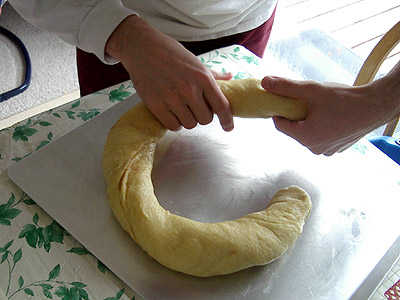
Then I twisted the dough and brought the ends together, creating a loop.
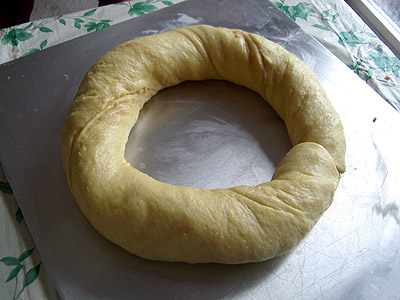
I covered the dough with a kitchen towel and set it aside to rise again.
Approximately an hour later I preheated the oven to 375. Just before placing it in the oven I brushed the outside of the dough with an egg wash (I used some of the egg whites left over from the 5 yokes that are in the dough). I put the dough in the oven and baked it for 30 minutes, rotating it once so that it would brown evenly about half way through.
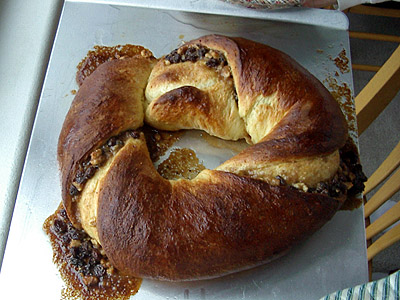
After the cake had cooled a bit, I slipped the toy baby into one of the seams that had burst open when the cake was baking.
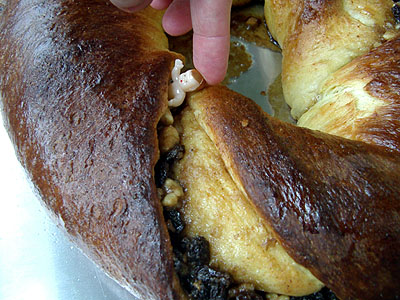
We found the toy baby in the baby shower section of a local party supply store. Resist the temptation to use a toy troll, Smurf, or army man if you cannot find a toy baby: some of your guests may take offense. Using a crucifix is also probably inappropriate: discovering Christ on the Cross in your cake is not nearly as festive as the baby Jesus.
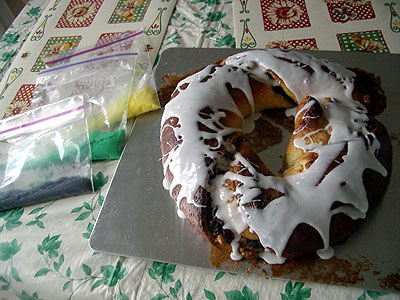
I coated the cake with a simple powdered sugar and lemon juice glaze (approximately one cup of powdered sugar mixed with the juice of half a lemon).
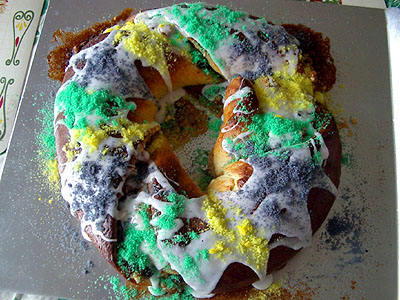
Then I sprinkled colored sugar over the top.
I made the colored sugar by putting 1/4 cup white sugar in a Ziploc bag with 5 or 6 drops of food coloring and shaking well. I was a bit concerned about where we were going to find purple food coloring when my wife reminded me that you can make purple by adding an equal amount of red and blue, two of the four colors in your basic grocery store food color kit (the other two being green and yellow, the two other colors needed to decorate this cake). I guess it is rather obvious which one of us thought about being an art major and which one has never painted in his life.
Aftermath: The Glucose Hangover
The cake turned out very good. The cake itself was rich and yellow and had a nice, subtle spiced sweetness.
The icing and the filling were a bit much for me. Three hours after eating a couple of slices my teeth started throbbing and I felt let down like a kid who just ate his whole bag of Halloween candy. Perhaps if you are raised on a Southern diet of Krispy Kreme Donuts, Pecan Pie, and Goo Goo Clusters you can handle this much sugar, but for me it was too much. My wife sufferred no ill effects, but she exercised more restraint, choosing to have only one slice of cake with her tea.
But perhaps that is the point, isn't it? Indulge yourself in such excess on the final day before Lent that you won't miss all of the treats you can't eat again until Easter. Well, at least not if you are Catholic.
Happy Mardi Gras, all.












 If there is one book that I would recommend to an amateur baker interested in experimenting with artisan breads, Peter Reinhart's
If there is one book that I would recommend to an amateur baker interested in experimenting with artisan breads, Peter Reinhart's 